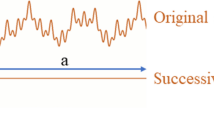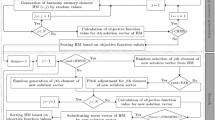Abstract
A methodology using adaptive time series analysis is tested on data from a seismometer monitoring the north end building (NEB) of the Virgo interferometer during four acoustic noise injections. Empirical mode decomposition (EMD) is used for adaptive detrending, while the recently developed time-varying filter EMD algorithm is used for narrowband mode extraction. Mode persistency is evaluated with detrended fluctuation analysis, and denoising is achieved by setting a threshold \(H_{\text {thr}}\) on the Hurst exponent of the obtained modes. The adopted methodology is proven useful in adaptively separating the seismic noise induced by the acoustic noise injections from the underlying nonlinear non-stationary recordings of the seismometer monitoring NEB. The Hilbert–Huang transform provides a high-resolution time–frequency representation of the data. Furthermore, the local Hurst exponent exhibits a drop due to the injections that is of the same order of \(H_{\text {thr}}\). This suggests that the local Hurst exponent could be calculated as an initial step in order to select the threshold \(H_{\text {thr}}\). The algorithms could be used for detector characterisation purposes such as the investigation of non-Gaussian noise.









Similar content being viewed by others
References
Aasi, J., Abadie, J., Abbott, B., Abbott, R., Abbott, T., Abernathy, M., et al. (2012). The characterization of Virgo data and its impact on gravitational-wave searches. Classical and Quantum Gravity, 29(15), 155002.
Abbott, B. P., Abbott, R., Abbott, T., Abernathy, M., Acernese, F., Ackley, K., et al. (2016). Characterization of transient noise in advanced Ligo relevant to gravitational wave signal gw150914. Classical and Quantum Gravity, 33(13), 134001.
Accadia, T., Acernese, F., Alshourbagy, M., Amico, P., Antonucci, F., Aoudia, S., et al. (2012). Virgo: A laser interferometer to detect gravitational waves. Journal of Instrumentation, 7(03), P03012.
Accadia, T., Acernese, F., Antonucci, F., Astone, P., Ballardin, G., Barone, F., et al. (2010). Calibration and sensitivity of the Virgo detector during its second science run. Classical and Quantum Gravity, 28(2), 025005.
Accadia, T., Acernese, F., Antonucci, F., Astone, P., Ballardin, G., Barone, F., et al. (2011). Automatic alignment system during the second science run of the Virgo interferometer. Astroparticle Physics, 34(6), 327332.
Accadia, T., Acernese, F., Antonucci, F., Astone, P., Ballardin, G., Barone, F., et al. (2011). Performance of the Virgo interferometer longitudinal control system during the second science run. Astroparticle Physics, 34(7), 521527.
Accadia, T., Acernese, F., Astone, P., Ballardin, G., Barone, F., Barsuglia, M., et al. (2011). Characterization of the Virgo seismic environment. Classical and Quantum Gravity, 29(2), 025005.
Acernese, F., Agathos, M., Agatsuma, K., Aisa, D., Allemandou, N., Allocca, A., et al. (2014). Advanced Virgo: A second-generation interferometric gravitational wave detector. Classical and Quantum Gravity, 32(2), 024001.
Acernese, F., Alshourbagy, M., Amico, P., Antonucci, F., Aoudia, S., Arun, K., et al. (2008). Lock acquisition of the Virgo gravitational wave detector. Astroparticle Physics, 30(1), 2938.
Acernese, F., Amico, P., Alshourbagy, M., Antonucci, F., Aoudia, S., Astone, P., et al. (2007). Status of Virgo detector. Classical and Quantum Gravity, 24(19), S381.
Acernese, F., Antonucci, F., Aoudia, S., Arun, K., Astone, P., Ballardin, G., et al. (2010). Performances of the Virgo interferometer longitudinal control system. Astroparticle Physics, 33(2), 7580.
Barone, F., De Rosa, R., Eleuteri, A., Milano, L., & Qipiani, K. (2002). The environmental monitoring system of Virgo antenna for gravitational wave detection. IEEE Transactions on Nuclear Science, 49(2), 405410.
Bianchi, S., Longo, A., & Plastino, W. (2018). A new methodological approach for worldwide beryllium-7 time series analysis. Physica A: Statistical Mechanics and Its Applications, 501, 377387.
Bianchi, S., Longo, A., Plastino, W., & Povinec, P. (2018). Evaluation of 7be and 133xe atmospheric radioactivity time series measured at four ctbto radionuclide stations. Applied Radiation and Isotopes, 132, 2428.
Bianchi, S., & Plastino, W. (2018). Uranium time series analysis: A new methodological approach for event screening categorisation. Journal of Environmental Radioactivity, 183, 3740.
Bianchi, S., Plastino, W., Brattich, E., Djurdjevic, V., Longo, A., Hernandez-Ceballos, M. A., et al. (2019). Analysis of trends, periodicities, and correlations in the beryllium-7 time series in northern Europe. Applied Radiation and Isotopes, 148, 160167.
Blackburn, L., Cadonati, L., Caride, S., Caudill, S., Chatterji, S., Christensen, N., et al. (2008). The LSC glitch group: Monitoring noise transients during the fifth LIGO science run. Classical and Quantum Gravity, 25(18), 184004.
Bradaschia, C., Del Fabbro, R., Di Virgilio, A., Giazotto, A., Kautzky, H., Montelatici, V., et al. (1990). The Virgo project: A wide band antenna for gravitational wave detection. Nuclear Instruments and Methods in Physics Research Section A: Accelerators, Spectrometers, Detectors and Associated Equipment, 289(3), 518525.
Brüel & kjaer amplifier nexus 2690. https://www.bksv.com/media/doc/bp1702.pdf.
Brüel & kjaer microphone model 4193-l-004. https://www.bksv.com/en/products/transducers/acoustic/microphones/microphone-preamplifier-combinations/4193-L-004.
Cuoco, E., Calamai, G., Fabbroni, L., Losurdo, G., Mazzoni, M., Stanga, R., et al. (2001). On-line power spectra identification and whitening for the noise in interferometric gravitational wave detectors. Classical and Quantum Gravity, 18(9), 1727.
Daw, E., Giaime, J., Lormand, D., Lubinski, M., & Zweizig, J. (2004). Long-term study of the seismic environment at Ligo. Classical and Quantum Gravity, 21(9), 2255.
Driggers, J., Harms, J., & Adhikari, R. (2012). Subtraction of newtonian noise using optimized sensor arrays. Physical Review D, 86(10), 102001.
Eke, A., Herman, P., Kocsis, L., & Kozak, L. (2002). Fractal characterization of complexity in temporal physiological signals. Physiological Measurement, 23(1), R1.
Falxa, M., Fiorucci, D., Fiori, I., Paoletti, F., Harms, J., & Barsuglia, M. Acoustic characterization of advanced virgo buildings. https://tds.virgo-gw.eu/?content=3&r=14737.
Fiorucci, D., Harms, J., Barsuglia, M., Fiori, I., & Paoletti, F. (2018). Impact of infrasound atmospheric noise on gravity detectors used for astrophysical and geophysical applications. Physical Review D, 97(6), 062003.
Guralp triaxial broadband seismometer 40t60s. http://www.guralp.com/products/instruments/guralp-40-series.
Harms, J. (2015). Terrestrial gravity fluctuations. Living Reviews in Relativity, 18(1), 3.
Holst, M., Sarbach, O., Tiglio, M., & Vallisneri, M. (2016). The emergence of gravitational wave science: 100 years of development of mathematical theory, detectors, numerical algorithms, and data analysis tools. Bulletin of the American Mathematical Society, 53(4), 513554.
Huang, N. (2014). Hilbert–Huang transform and its applications (Vol. 16). Singapore: World Scientific.
Huang, N., Shen, Z., Long, S., Wu, M., Shih, H., Zheng, Q., et al. (1998). The empirical mode decomposition and the Hilbert spectrum for nonlinear and non-stationary time series analysis. Proceedings of the Royal Society of London A: Mathematical, Physical and Engineering Sciences, 454, 903995.
Ihlen, E. A. F. (2012). Introduction to multifractal detrended fluctuation analysis in Matlab. Frontiers in Physiology, 3, 141.
Jones, G., & Boashash, B. (1990). Instantaneous frequency, instantaneous bandwidth and the analysis of multicomponent signals. In International conference on acoustics, speech, and signal processing, IEEE, 24672470.
LIGO Scientific Collaboration and Virgo Collaboration, et al. (2019). A guide to LIGO-Virgo detector noise and extraction of transient gravitational-wave signals. arXiv:1908.11170 (arXiv preprint).
Li, H., Li, Z., & Mo, W. (2017). A time varying filter approach for empirical mode decomposition. Signal Processing, 138, 146158.
Longo, A., Bianchi, S., Plastino, W., Idźkowski, B., Suchiński, M., & Bulik, T. (2019). Fractal analysis of data from seismometer array monitoring virgo interferometer. Pure and Applied Geophysics.
Longo, A., Bianchi, S., & Plastino, W. (2018). Xenon and radon time series analysis: A new methodological approach for characterising the local scale effects at CTBT radionuclide network. Applied Radiation and Isotopes, 139, 209216.
Longo, A., Bianchi, S., & Plastino, W. (2019). tvf-emd based time series analysis of 7be sampled at the CTBTO-IMS network. Physica A: Statistical Mechanics and Its Applications, 523, 908914.
Loughlin, P. J., & Davidson, K. L. (2001). Modified cohen-lee time-frequency distributions and instantaneous bandwidth of multicomponent signals. IEEE Transactions on Signal Processing, 49(6), 11531165.
Mukund, N., Coughlin, M., Harms, J., Biscans, S., Warner, J., Pele, A., Thorne, K., Barker, D., Arnaud, N., & Donovan, F., et al. (2018). Predicting surface wave velocities at gravitational wave observatories using archival seismic data. arXiv:1812.05185 (arXiv preprint).
Peng, C. K., Havlin, S., Stanley, H. E., & Goldberger, A. L. (1995). Quantification of scaling exponents and crossover phenomena in non-stationary heartbeat time series. Chaos: An Interdisciplinary Journal of Nonlinear Science, 5(1), 8287.
Plastino, W., Plenteda, R., Azzari, G., Becker, A., Saey, P., & Wotawa, G. (2010). Radioxenon time series and meteorological pattern analysis for CTBT event categorisation. Pure and Applied Geophysics, 167(4–5), 559573.
Powell, J., Trifirò, D., Cuoco, E., Heng, I. S., & Cavaglià, M. (2015). Classification methods for noise transients in advanced gravitational-wave detectors. Classical and Quantum Gravity, 32(21), 215012.
Schroeder, M. R., & Kuttruff, K. (1962). On frequency response curves in rooms. Comparison of experimental, theoretical, and Monte Carlo results for the average frequency spacing between maxima. The Journal of the Acoustical Society of America, 34(1), 7680.
Sundar, A., Pahwa, V., Das, C., Deshmukh, M., & Robinson, N. (2016). A comprehensive assessment of the performance of modern algorithms for enhancement of digital volume pulse signals. International Journal of Pharma Medicine and Biological Sciences, 5(1), 91.
Unser, M., Aldroubi, A., & Eden, M. (1993). B-spline signal processing. I. Theory. IEEE Transactions on Signal Processing, 41(2), 821833.
Van Den Brand, J., Beker, M., Doets, M., Hennes, E., & Rabeling, D. (2010). Einstein telescope site selection: Seismic and gravity gradient noise. Journal of Physics: Conference Series, 203, 012076.
Weiss, R. (1972). Electromagnetically coupled broadband gravitational antenna. Quarterly progress report 105, research laboratory of electronics.
Wu, Z., & Huang, N. (2004). A study of the characteristics of white noise using the empirical mode decomposition method. Proceedings of the Royal Society of London A: Mathematical, Physical and Engineering Sciences, 460(2046), 15971611.
Acknowledgements
Data shown in the paper were taken using the Advanced Virgo environmental monitoring system. We acknowledge the Italian Istituto Nazionale di Fisica Nucleare (INFN), the French Centre National de la Recherche Scientifique (CNRS) and the Foundation for Fundamental Research on Matter supported by the Netherlands Organisation for Scientific Research, for the construction and operation of the Virgo detector and the creation and support of the EGO consortium.
Author information
Authors and Affiliations
Corresponding author
Additional information
Publisher's Note
Springer Nature remains neutral with regard to jurisdictional claims in published maps and institutional affiliations.
Rights and permissions
About this article
Cite this article
Longo, A., Bianchi, S., Plastino, W. et al. Adaptive Denoising of Acoustic Noise Injections Performed at the Virgo Interferometer. Pure Appl. Geophys. 177, 3395–3406 (2020). https://doi.org/10.1007/s00024-020-02428-w
Received:
Revised:
Accepted:
Published:
Issue Date:
DOI: https://doi.org/10.1007/s00024-020-02428-w




